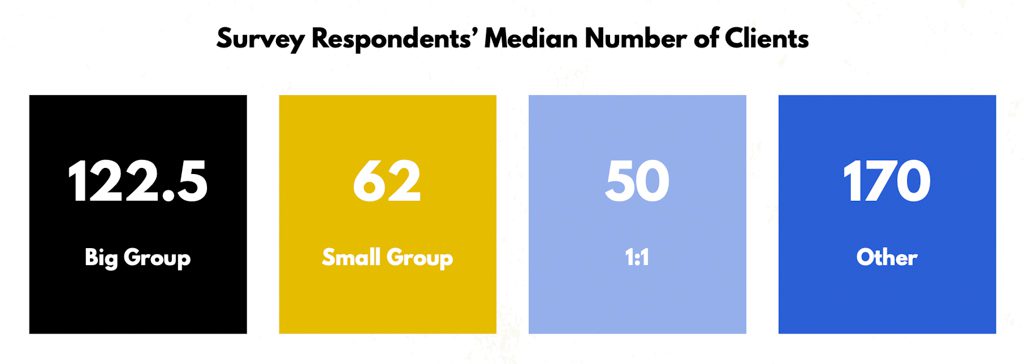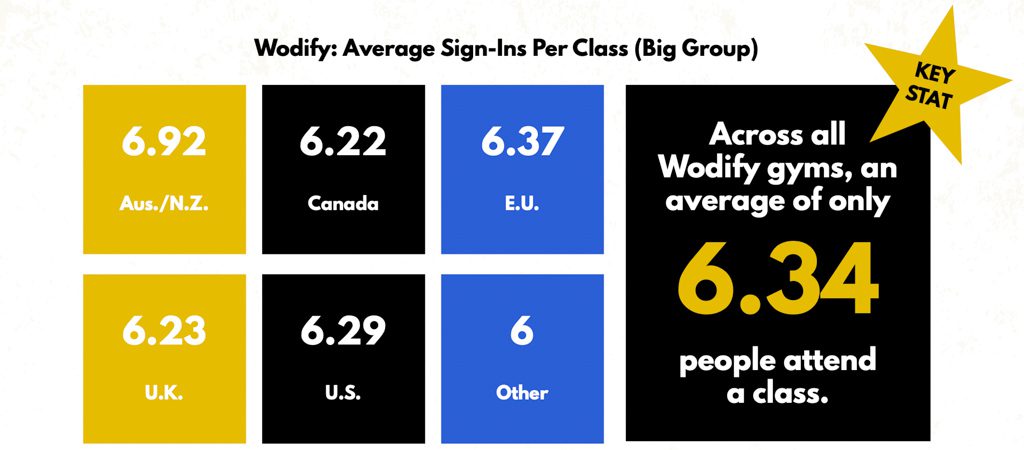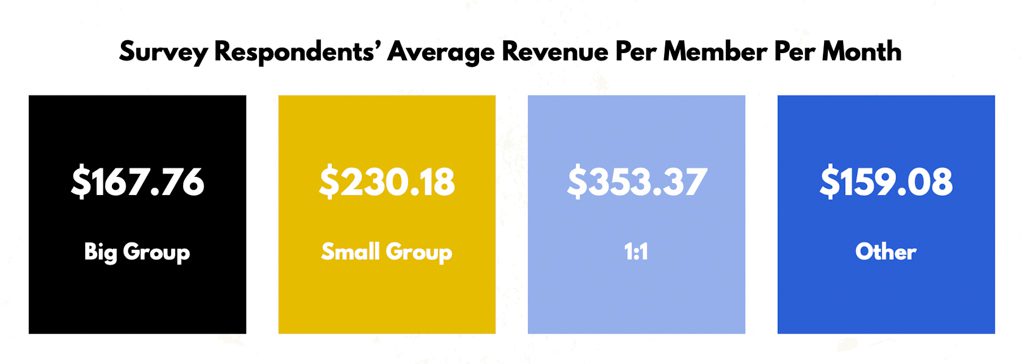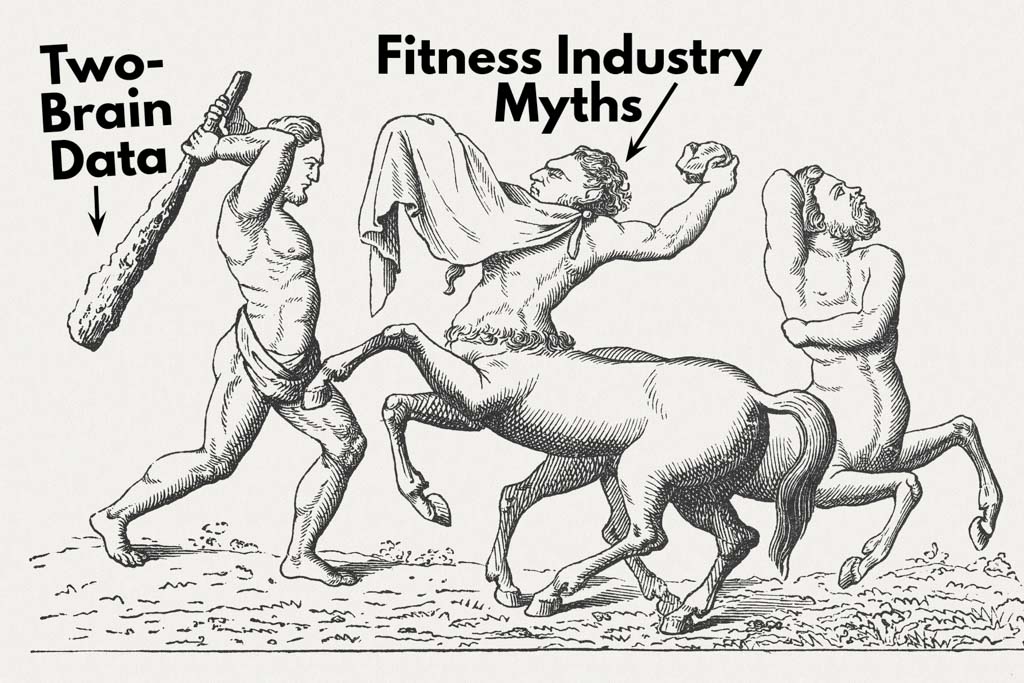Fitness myths must die:
“This cream melts fat.”
“This movement turns fat into muscle.”
“Add 10 lb. of lean muscle in five days.”
And so on.
Here’s another bad one—it’s actually a gym killer:
“You’ll be super profitable if you get 300 members and run big classes with 12 people from dawn to dusk!”
Here’s the problem: Gym owners know fat-melting creams are BS, but many of them still swallow hooks thrown out by “business experts” who don’t have a shred of data to back up their claims.
Two-Brain has been busting business myths with data for years, and I’m going to give you a peak inside our 2024 “State of the Industry” report so you can see the power of real numbers.
If you want to review the entire report and use it to evaluate the health of your gym, you can get it here: “State of the Industry.”
The No-Data Daisy Chain of Doom
“Get 200 clients and be profitable” is a fool’s errand that creates all sorts of errors.
I’ll lay out some problems, then show you real-life numbers and give you solutions based on hard data.
Here’s a very common daisy chain of errors that are triggered by the myth that you need 200-300 members to be profitable selling big-group fitness:
- You’re focused on volume, so you use low rates to get members, and you just can’t turn a profit.
- You always need more clients, so you don’t focus on retention.
- You spend lots of money on ads for challenges and similar gimmicks but don’t have an airtight onboarding plan because you just want to get these people into classes ASAP.
- You think you’ll have huge classes, so you rent a monster space and fill it will a mountain of gear.
- You run classes from 5 a.m. to 5 p.m. and work 14-hour days yourself, or you’re desperate for staff so you build an army of modestly skilled part-timers who trade coaching for membership (and reduce your tally of paying clients).
- You pay other coaches $25 or $30 to run classes that bring in $20 in revenue.
- Your full-time trainers can’t earn enough coaching classes to develop careers that support families, so they leave to work in other fields.
- Your high-churn gym is burning through the market, and it’s getting harder and hard to generate warm leads.
I’ll stop here even though I could go further.
Everything I laid out here is common when a big-group gym owner tries to build a business on a myth. I have seen all this played out too many times in the real world, and all too often these errors are fatal.
Think about just one aspect for a minute: You plan to serve 300 people so you rent a 9,000 square-foot space for five years and buy 30 barbells, but you don’t create a masterful marketing, onboarding and retention plan. So you end up with classes of seven that require just 2,500 square feet (or less). Your cash is tied up in gear that’s acquiring dust, and your lease is bleeding you out month by month.
Let’s look hard at reality.
Our 2024 survey of gym owners produced this stat on client count:

Just so it’s clear: Half of all gyms surveyed have 122 clients or fewer. Fifty percent.
If the average big group gym (CrossFit, HIIT, bootcamp, etc.) has 122 members, it doesn’t need seven coaches plus the owner to serve its clients. And it probably doesn’t need a cavernous warehouse and a fleet of air bikes and rowing machines.
I don’t like “probably,” so let’s go back to the data, this time from Wodify, which analyzed thousands of gyms to produce these stats for us:

Clarity: Across all of Wodify’s gyms, fewer than seven clients attend the average class.
I’ll go one step further. Here’s our survey respondents’ average revenue per member per month (ARM):

So if a gym has about 122 clients at $167 a month, can the owner cover the bills and earn a good living—say, $100,000 a year?
Not if they lease 8,000 square feet, spend lots of money on ads and hire too many coaches.
What if they leased 3,000 square feet, acquired and held high-value clients with surefire referral and retention plans, and used personal training and other services to drive ARM up to $250 a month?
One more question: What if they served 240 members with group, PT and nutrition for an ARM of $250 a month, and the owner paid two full-timers $50,000-$75,000 a year to deliver service in 5,300 square feet? (Answer, based on more data: That owner could become a millionaire.)
Use Numbers, Do Science
This is how data sinks myths and helps you get real results.
You tell your clients to ignore the late-night infomercials and trust you to help them lose weight with a proven, sustainable plan delivered by an experienced pro.
Same deal here. I’m telling you to ignore too-good-to-be-true nonsense and myths from the Dark Ages of the fitness industry.
You no longer have make guesses and pray or waste your trust on snake-oil salespeople who promote unproven plans. You can check their work, call their bluffs and run your own numbers to find truth.
Two-Brain will always help you do that.
Use numbers.
Do science.
Evolve.
Here are the numbers you need to build a strong, thriving gym business in 2025: “State of the Industry.”

